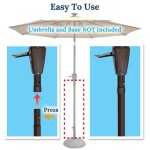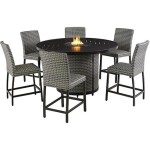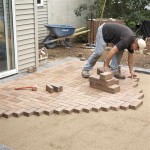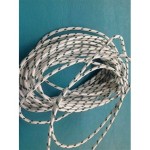Patio Design for Small Yards: Maximizing Space and Style
Designing a patio for a small yard presents a unique set of challenges and opportunities. Limited square footage requires careful planning and thoughtful design choices to create an outdoor space that is both functional and aesthetically pleasing. The key lies in maximizing every inch, selecting appropriate materials, and incorporating design elements that visually expand the area.
The goal of a small yard patio design is to create a welcoming and usable extension of the home. This involves considering the yard's existing features, the homeowner's lifestyle, and the desired functions the patio should serve. Whether it’s an intimate dining area, a relaxing lounge space, or a compact outdoor kitchen, a well-designed patio can significantly enhance the enjoyment and value of a small outdoor area.
Optimizing Space with Strategic Layouts
The layout is arguably the most crucial aspect of designing a patio for a small yard. The arrangement of furniture, landscaping, and other elements directly impacts the perceived size and usability of the space. A cluttered or poorly planned layout can make a small yard feel even smaller, while a strategic design can create the illusion of spaciousness and improve flow.
One effective technique is to utilize vertical space. Instead of focusing solely on ground-level features, consider incorporating vertical structures such as trellises, wall planters, or even a small water feature. These elements draw the eye upward, creating a sense of height and making the yard feel less constricted. Vertical gardening, for example, can add greenery and visual interest without sacrificing valuable ground space.
Multifunctional furniture is another essential consideration. Pieces that can serve multiple purposes, such as a storage bench that doubles as seating or a folding table that can be easily stored away when not in use, are ideal for small spaces. Opting for furniture with clean lines and a minimalist design can also help to create a more open and airy feel.
Consider the flow of traffic within the yard. Creating clear pathways and avoiding obstacles can improve the sense of spaciousness and make the patio more accessible. Using pavers or stepping stones to define pathways can also add visual interest and guide the eye through the space. Avoid overcrowding the patio with too much furniture or decorative elements, as this can make it feel cramped and uncomfortable.
Zoning is a useful strategy for delineating different areas within a small patio. For instance, a distinct dining area can be created using a different type of paving or by defining the space with a low wall or planter. A separate lounge area can be established with comfortable seating and soft lighting. Defining these zones creates a sense of order and makes the patio feel more organized and functional.
Corner spaces often go underutilized in small yards. Maximizing these areas with custom-built seating or a small outdoor kitchen can significantly increase the usable square footage of the patio. Consider installing a corner bench with built-in storage or a compact grill station to make the most of these often-overlooked spaces.
Lighting plays a crucial role in creating the desired ambiance and extending the usability of the patio into the evening hours. String lights, lanterns, or strategically placed spotlights can enhance the atmosphere and make the space feel more inviting. Consider using solar-powered lights to reduce energy consumption and simplify installation. Avoid using overly bright lights, as these can be harsh and detract from the overall ambiance. Instead, opt for warm, soft lighting that creates a relaxed and inviting atmosphere.
Selecting Materials and Finishes for Small Patios
The choice of materials and finishes significantly impacts the overall look and feel of a small yard patio. The right materials can enhance the sense of spaciousness, complement the surrounding landscape, and create a cohesive design. Consider the durability, maintenance requirements, and aesthetic qualities of each material before making a selection.
Pavers are a popular choice for patio surfaces due to their durability, versatility, and wide range of colors, shapes, and sizes. Using larger pavers can create a sense of spaciousness, while smaller pavers can add texture and visual interest. Consider using light-colored pavers to reflect sunlight and make the patio feel brighter and more open. Darker pavers can create a more intimate and cozy atmosphere, but they may also make the space feel smaller.
Natural stone is another excellent option for patio surfaces. Stone provides a timeless and elegant look and can be used to create a variety of different styles, from rustic to modern. Consider using flagstone, slate, or limestone to create a unique and visually appealing patio surface. Natural stone requires minimal maintenance and is highly durable, making it a long-lasting investment.
Composite decking is a low-maintenance alternative to traditional wood decking. It is resistant to rot, decay, and insect damage, making it a durable and long-lasting choice for patio surfaces. Composite decking is available in a variety of colors and textures, allowing you to create a customized look that complements your home's exterior. It is also slip-resistant, making it a safe option for families with children or pets.
Gravel is a cost-effective and versatile option for patio surfaces. It is easy to install and maintain and can be used to create a variety of different styles, from rustic to modern. Consider using pea gravel, crushed stone, or decomposed granite to create a unique and visually appealing patio surface. Gravel is also permeable, allowing water to drain easily and preventing puddles from forming.
For vertical elements, consider using materials that complement the patio surface. Wood is a popular choice for trellises, fences, and planters. It provides a warm and natural look and can be easily stained or painted to match the surrounding landscape. Metal is another excellent option for vertical elements. It is durable and low-maintenance and can be used to create a variety of different styles, from contemporary to industrial.
The choice of furniture materials also plays a crucial role in the overall design. Wicker furniture is lightweight and comfortable and can be used to create a relaxed and inviting atmosphere. Metal furniture is durable and low-maintenance and can be used to create a more modern and sophisticated look. Wood furniture provides a warm and natural look and can be easily stained or painted to match the surrounding landscape. Consider using weather-resistant materials to ensure that your furniture lasts for many years.
Incorporating Landscaping to Enhance Small Patios
Landscaping is an essential element of any patio design, but it is particularly important in small yards. Plants can add color, texture, and visual interest, creating a more inviting and relaxing atmosphere. The right landscaping can also help to define the space, provide privacy, and even reduce noise pollution. Careful plant selection and strategic placement are key to maximizing the impact of landscaping in a small patio.
Vertical gardening is an excellent way to add greenery to a small patio without sacrificing valuable ground space. Wall planters, hanging baskets, and trellises can be used to create a lush and verdant display. Consider planting herbs, vegetables, or flowering vines to add both beauty and functionality to the patio. Vertical gardens can also help to soften hard surfaces and create a more natural and inviting atmosphere.
Container gardening is another versatile option for adding plants to a small patio. Pots and containers can be easily moved and rearranged, allowing you to customize the look of your patio to suit your changing needs and preferences. Consider using a variety of different sizes, shapes, and colors of pots to create a visually appealing display. Planting flowers, shrubs, and small trees in containers can add color, texture, and privacy to the patio.
When selecting plants for a small patio, consider their size, growth habits, and maintenance requirements. Choose plants that are well-suited to the local climate and that will not outgrow the available space. Dwarf varieties of trees and shrubs are ideal for small patios, as they provide the same visual interest as larger plants without taking up as much room. Consider planting shade-tolerant plants beneath trees or overhangs to maximize the use of available space.
Creating a focal point with landscaping can help to draw the eye and create a sense of depth in a small patio. A small tree, a striking sculpture, or a colorful flower bed can serve as a focal point, adding visual interest and making the patio feel more inviting. Consider using contrasting colors and textures to create a focal point that stands out from the surrounding landscape.
Using landscaping to create privacy is particularly important in small yards, where neighboring properties may be close by. Planting tall shrubs, trees, or vines along the perimeter of the patio can create a natural screen, providing privacy and reducing noise pollution. Consider using evergreen plants to maintain privacy year-round. Alternatively, a decorative screen or fence can provide similar privacy while adding visual interest.
The use of ground cover plants can help to soften hard surfaces and create a more natural and inviting atmosphere. Consider planting creeping thyme, sedum, or other low-growing plants between pavers or stepping stones to create a seamless transition between the patio surface and the surrounding landscape. Ground cover plants can also help to suppress weeds and reduce the need for maintenance.
Finally, consider incorporating water features into the landscape design. A small fountain, birdbath, or pond can add a sense of tranquility and relaxation to the patio. The sound of water can help to mask noise pollution and create a more peaceful and inviting atmosphere. Water features can also attract birds and other wildlife, adding to the natural beauty of the patio.

Small Backyard Patio Design Layouts And Material List Mypatiodesign Com

Small Backyard Design Landscaping Network

Patio Design Ideas Landscaping Around Backyard Designs Outdoor Decor

The Best Small Patio Ideas To Eoy This Summer

33 Small Backyard Landscape Ideas

Small Backyard Design Landscaping Network

40 Best Small Garden Ideas Designs On A Budget

45 Stylish Small Patio Ideas Designer Patios Tips And Tricks

93 Creative Small Patio Ideas For Your Backyard Retreat

Seven Small Garden Design Ideas To Transform Your Outdoor Space Marshalls
Related Posts








